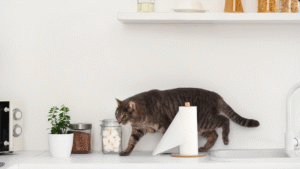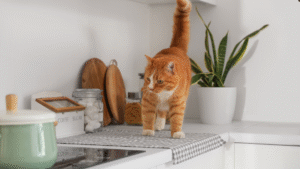If you’ve ever walked into your kitchen to find your cat proudly perched on your countertop, you’re not alone. Counter-surfing cats are one of the most common frustrations for cat owners. Whether it’s the allure of food smells, running water, or simply the higher vantage point, many cats can’t resist the temptation to jump on counters.
It’s annoying—they get in the way while you’re cooking—and it can even be dangerous if they knock over hot pans. Thankfully, it is possible to stop your cat from jumping on counters, and you can do it without yelling or being mean.

Why Do Cats Jump on Counters?
The first step to solving the problem is understanding the reasons behind the behavior. This makes it easier to help your cat change and stop jumping on counters.
Here are the top reasons cats jump on counters:
-
Curiosity: Cats love exploring new places, smells, and objects—especially if you spend a lot of time in the kitchen.
-
Height and security: Cats instinctively prefer high places because they feel safer and have a better vantage point.
-
Food: The smell of food, crumbs, or even dirty dishes can easily attract your cat.
-
Running water: Some cats are fascinated by running water and will jump on counters to reach the sink.
-
Attention-seeking: Cats often repeat behaviors that get them attention—even if it’s negative attention.
Once you understand what motivates your cat’s jumping, you’ll be better equipped to help them break the habit.

5 Solutions to Stop Your Cat from Jumping on Counters
1. Provide Attractive Alternatives
One of the hardest parts about changing a behavior is that cats rarely give something up without a suitable replacement.
If your cat jumps on the counter to get a better view or to stay close to you, they’ll need an “approved” elevated spot that provides the same reward.
Create Cat-Friendly Elevated Spaces
Provide a cat tree, cat shelf, or window perch near the kitchen. This gives your cat a place to climb and observe from a safe distance without using your counters.
For example:
-
A tall cat tower near the kitchen door allows them to watch you while you cook.
-
Floating shelves or wall-mounted perches near a sunny window are both stylish and functional.
Make these spots more appealing by adding soft bedding, catnip, or interactive toys. The goal is to make the new location more rewarding than the countertop.
Encourage Their Use
Redirect your cat to the new perch each time they try to get on the counter and reward them immediately.
Use treats, verbal praise, or a quick play session. Consistency and positive reinforcement will teach your cat that the new location is the “right” place to be.
2. Make the Counter Unattractive
If the counter no longer provides a positive experience, your cat will lose interest in it.
The idea is to remove the rewards and introduce mild deterrents—never anything that scares or hurts your cat.
Safe Deterrents
Try these proven methods:
-
Aluminum foil: Cats dislike the sound and texture. Lay sheets of it on your counters when not in use.
-
Double-sided tape: Cats don’t like sticky surfaces. Use products like Sticky Paws on the edges or favorite jumping spots.
-
Plastic carpet runners (spiky side up): These provide a slightly uncomfortable surface without harming your cat.
Use these deterrents for a few days or weeks until your cat learns that counters = discomfort.

Remove Temptations
Don’t make the counters a playground. Wipe up crumbs, cover food, and put away anything that might attract your cat.
If they like the sink, cover it or empty out any standing water when you’re done using it.
By combining deterrents with removing rewards, you’ll make the counters much less appealing.
3. Reinforce Positive Behavior
Punishment is never the answer for changing your cat’s long-term behavior. It can make them fearful and damage your bond.
Positive reinforcement is far more effective and teaches your cat what you do want them to do.
Redirect and Reward
Whenever you see your cat preparing to jump on the counter, calmly interrupt the behavior—perhaps with a gentle noise like a light clap or “ah-ah”—and guide them to their designated perch.
Once they’re on the perch, reward them immediately with a treat, petting, or a toy.
Over time, they’ll learn that staying off the counter and going to their spot results in rewards, while jumping up leads to nothing.

Consistency Is Key
Make sure everyone in the household follows the same rules. If one person allows the cat on the counter while another discourages it, your cat will be confused and the behavior will continue.
Set clear boundaries and stick to them. For example:
-
Not allowed on counters at any time
-
Allowed only when the counters are covered
-
Allowed in certain rooms but not in the kitchen
Consistency helps your cat understand expectations and reinforces good habits.
4. Address Underlying Causes
If you’ve tried everything and your cat still insists on counter-surfing, there may be an underlying reason for their behavior.
Issues such as boredom, hunger, or lack of stimulation can lead to unwanted behaviors like jumping on counters.
Boredom and Enrichment
Cats need daily physical and mental stimulation. A bored cat will find their own entertainment—and often, that means trouble.
Try adding:
-
Interactive toys like wand teasers or laser pointers
-
Puzzle feeders or treat-dispensing toys that make them “work” for food
-
Scheduled play sessions (at least 15 minutes, twice a day)
Feeding and Water Habits
Your cat may jump on the counter because they’re hungry or curious about your food.
-
Stick to a regular feeding schedule to reduce food-seeking behavior.
-
Offer small, healthy snacks throughout the day using puzzle feeders.
-
Ensure they have constant access to fresh water. If they love running water, try a cat water fountain.
By addressing these needs directly, you can greatly reduce their urge to climb onto counters.
Related:How To Train Your Cat To Perform Tricks
5. Use Training Tools and Techniques
Cats are surprisingly trainable when approached with patience and consistency.
Clicker Training
Clicker training is an excellent, proven way to reinforce positive behavior.
You’ll need a clicker (a small device that makes a clicking sound) and some treats.
Here’s how to start:
-
Click and reward every time your cat performs the desired behavior (e.g., staying off the counter, sitting on their perch).
-
Gradually add verbal cues like “stay” or “off.”
-
Over time, your cat will associate the command with the action and reward.
Motion-Activated Devices (Use as a Last Resort)
If your cat continues to climb on counters when you’re not around, try motion-activated air sprayers or sound deterrents designed for pets.
These emit a short burst of air or sound when triggered—startling your cat but not harming them.
Use them sparingly, as some cats may become anxious. Always pair these tools with positive reinforcement and environmental enrichment.
Additional Tips to Keep Your Cat Off Counters
-
Keep counters clean: Don’t leave food, crumbs, or dripping water unattended.
-
Close blinds or block access: If your cat jumps up to look out the window, offer an alternative viewing spot.
-
Never use physical punishment: Yelling, spraying water, or hitting your cat can cause stress, anxiety, and mistrust.
-
Be patient: Behavioral change takes time. Cats need consistency and repetition to form new habits.
The Bottom Line
So, there you have it—five effective and long-lasting ways to stop your cat from jumping on counters, plus a few bonus tips to help reinforce good behavior and maintain success over time.
You can even combine two or more of these methods for faster results.
Remember, it’s not about punishment—it’s about understanding why your cat is doing it and gently redirecting their natural instincts.
By offering appropriate climbing spots, making counters less appealing, reinforcing positive behavior, and addressing underlying causes like boredom or hunger, you can easily teach your cat to stay off the counters.
Every cat is different. Some will catch on in a week, while others may take a few months. Patience, consistency, and compassion are the keys to success.
- 5 Cheap Alternatives To Dog Training Equipment - November 12, 2025
- Homemade Calming Spray To Help Dogs During Training - November 12, 2025
- 7 DIY Dog Training Tools You Can Make From Household Items - November 12, 2025
